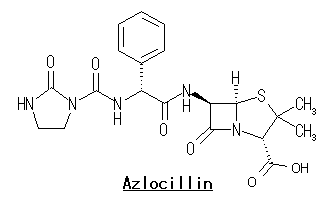Drug Nomenclature
International Nonproprietary Names (INNs) in main languages (French, Latin, Russian, and Spanish):

Azlocillin Sodium
Drug Nomenclature
INNs in main languages (French, Latin, Russian, and Spanish):
Incompatibility
Azlocillin sodium has been reported to be incompatible with aminoglycosides, ciprofloxacin, metronidazole, andtetracyclines.
Adverse Effects and Precautions
As for Carbenicillin Sodium. Prolongation of bleeding time has been less frequent and less severe with azlocillin than with carbenicillin.
Hypouricaemia
Reports of transient asymptomatic decreases in serum-uric acid concentrations during treatment with azlocillin.
Sodium content
Each g of azlocillin sodium contains about 2.1 mmol of sodium. As azlocillin sodium has a lower sodium content than carbenicillin sodium, hypernatraemia and hypoka-laemia are less likely to occur.
Interactions
As for Benzylpenicillin.
Antibacterials
For the effect of azlocillin on the clearance of cefotaxime, and a report of neurotoxicity. For reference to azlocillin affecting the disposition of ciprofloxacin.
Antimicrobial Action
Azlocillin has an antimicrobial action similar to that of piperacillin. Its activity in vitro against Enterobacteriaceae is generally less than that of mezlocillin or piperacillin, but it has comparable activity to piperacillin against Pseudomonas aeruginosa.
Pharmacokinetics
Azlocillin is not absorbed from the gastrointestinal tract to any significant extent. It has nonlinear dose-dependent pharmacokinetics. Doubling an intravenous dose results in more than double the plasma concentration. Between 20 and 46% of azlocillin in the circulation is bound to plasma proteins. The plasma half-life is usually about 1 hour, but is longer in neonates; in patients with renal impairment half-lives of 2 to 6 hours have been reported. Azlocillin is widely distributed in body tissues and fluids. It crosses the placenta into the fetal circulation and small amounts are distributed into breast milk. There is little diffusion into the CSF except when the meninges are inflamed. Azlocillin is metabolised to a limited extent. About 50 to 70% of a dose is excreted unchanged in the urine by glomerular filtration and tubular secretion within 24 hours of a dose, resulting in high urinary concentrations. Azlocillin is partly excreted in the bile where it is also found in high concentrations. Plasma concentrations are enhanced if probenecid is given. Azlocillin is removed by haemodialysis.
Uses and Administration
Azlocillin is a ureidopenicillin and, like piperacillin, is used mainly for the treatment of infections caused by Pseudomonas aeruginosa. It has been used particularly for septicaemia, and infections of the respiratory and urinary tracts, and also for peritonitis; for details of these infections, see under Choice of Antibacterial. Azlocillin is commonly used with an aminoglycoside; however, they should be given separately as they have been shown to be incompatible (see Incompatibility, above). Administration and dosage. Azlocillin is given intravenously as the sodium salt. Doses are expressed in terms of the equivalent amount of azlocillin; 1.05 g of azlocillin sodium is equivalent to about 1 g of azlocillin. A 10% solution in a suitable diluent is given by slow injection for doses of 2g or less; higher doses should be infused over 20 to 30 minutes. The usual adult dose is 5 g every 8 hours for life-threatening infections, or 2 g every 8 hours for less severe infections and urinary-tract infections. The following doses may be used for children: premature infants, 50 mg/kg twice daily; neonates less than 7 days old, 100 mg/kg twice daily; infants between 7 days and 1 year, 100 mg/kg three times daily; children up to 14 years, 75 mg/kg three times daily. Dosage of azlocillin may need to be adjusted in patients with hepatic or renal impairment (see below).
Administration in hepatic or renal impairment
The interval between doses of azlocillin may need to be increased to every 12 hours in moderate to severe renal impairment (creatinine clearance less than 30 mL/minute); additional dosage reductions may be needed in patients with both severe renal and hepatic impairment.
Single-ingredient Preparations
Australia: Securopen; Austria: Securopen; France: Securopen; Germany: Securopen; Ireland: Securopen; Italy: Securopen; Norway: Securopen; Spain: Securopen; United Kingdom: Securopen; United States: Azlin

